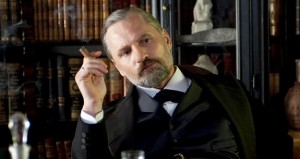Yesterday I caught up with David Cronenberg’s new movie, A Dangerous Method (2011) about the Freud/Jung divide embodied in their mutual patient Sabina Spielrein.
For all its period film denial of the present, I found it haunted by the “talking cure” practiced by Occupy and the desires that it evinces. What does Occupy want? The answer most often given in relation to the talking cure of consensus governance would be “empowerment.” The trouble with such tactics is that, after the initial break-through, resistance is generated from within and without.
In A Dangerous Method, Freud is obsessed with the resistance to psychoanalysis and subjugates everything to promoting “the sexual theory.”
As a creature of the psychopharmaceutical era–so many people take anti-depressants in New York that the river fish have measurable doses in their bodies– the film finds Freud vile and uncouth and is forced to find in Jung’s favor. It is Spielrein who raises the truly dangerous questions of resistance and the death drive that are now forcing the OWS talking cure to consider a different form of practice.
The film is a palimpsest: based on a 2003 play by Christopher Hampton, derived from a 1995 book by John Kerr, itself inspired by the 1970s and 80s discoveries of Spielrein’s papers. As Michael Billington spotted in his Guardian review, the play always wanted to be a film. What does the film want? It wants us to once again reject the version of the 1960s in which freedom and free love and open sexuality were supposedly equated. Such ideas are traced back to the beginning of psychoanalysis and emphasized by an unlikely stress on the concept of “freedom,” not a very psychoanalytic concept, and the disruptive presence of Otto Gross, played as a mix of Van Gogh in Lust for Life and Abbie Hoffman. You could wonder again at the fascination in English culture with spanking and its odd mix of philo- and anti-semitism. But let’s stick with the talking cure and its object, Sabina Spielrein.
Spielrein is not allowed much presence in the film as an intellectual, compared to the extensive scenes of her in hysterics or sexually involved with Jung. Here it’s worth noting that, as she wrote about the “essential homosexuality” of women, perhaps Jung and his male surrogates have protested too much?
In a brief scene, Spielrein presents the idea of her paper “Destruction as the Cause of Coming into Being” to Freud. The film can’t do much with this, because to acknowledge that Freud cited Spielrein in Beyond the Pleasure Principle would complicate the caricature of his being obsessed by pleasure/sex. Similarly, Spielrein’s own essay is a widely-ranging, hard-to-summarize assemblage of Nietzsche, Freud, Jung, Wagner, the Talmud and her own case-study of schizophrenia (you can find it on Psychoanalytic Electronic Publishing behind a pay-wall).
Within the film, what Spielrein wants is to be married to Jung and this her tragedy–not, as the last intertitle notes, that she was shot by the Nazis in 1942. What she herself wanted is a question beyond my scope here but it’s intriguing to think about a woman that inspired Freud, Jung and Melanie Klein and went on to organize child services for the Third International. And maybe read her letters alongside those of Rosa Luxemberg, recently translated?
What she seems to have known very well is that desire is complicated, indeed articulated by complexes. So to ask, as everyone does, “what does Occupy want?” is to revisit Freud’s least successful question: “what does a woman want?” Here Occupy is figured as the recalcitrant woman, demanding, but refusing to say what it is precisely that she wants. Such narratives refashion the complex anti-hierarchical and multi-tasking practice of Occupy into inarticulate need. It reduces the layers of feminist thought around Occupy from Arundati Roy, Judith Butler, Gayatri Spivak, Naomi Klein and many others to a simple demand line.
The “docile minds” desired by Big Pharma and neo-liberal governance alike supposedly have no such thing as an unconscious. The repressed cannot return, in this view, because there is nowhere for it to go. Spielrein argued otherwise, quoting her patient Martha N:
‘The suspicion can come into being in the real world in order to prove its right to exist.’ I have come to the conclusion that the chief characteristic of an individual is that he is ‘dividual’. The closer we approach our conscious thoughts, the more differentiated our images.
In this view, it’s not so surprising that Occupy has run into resistance as that its initial tactic of talking in groups was so successful. The anti-hierarchical group discussion was a tactic used by anti-psychiatry from Frantz Fanon’s experiments in Algeria and Tunisia to Félix Guattari’s clinic at La Borde, France, just as Deleuze made much of the “dividual.”
In a recent article on Deleuze and Guattari, Adam Shatz has pointed out how Deleuze asserted in an early essay that:
inner life (la vie intérieure)… was a bourgeois delusion: not for nothing did it sound like ‘domestic life’ (la vie d’intérieur).
Is it too semiotic and old-school to wonder if the very act of being outside, refusing interior life in the domestic sense, facilitated transformations in inner life? Again, we might stress the crucial presence of LBGTQI people in the Occupy movement, those unconstrained by what J. Jack Halberstam calls “family time.” The movement has placed a premium on “safe spaces” for discussion, calling out transphobia and able-ism as being every bit as disruptive to that safety as the old mantra of “race, gender, class.”
At the same time, Occupy encampments became spaces for those once offered care, such as the mentally ill, drug and/or alcohol dependent, and homeless people, to find space. The talking cure was stretched to its limits to deal with these “unmet needs.” Recently, at OWS, the General Assembly, and its operations twin the Spokescouncil, have all but ground to a halt thanks to the blockers. That is to say, one key element of consensus is the ability of any person to “block” a proposal on ethical or safety grounds that might cause them to leave the movement. However, some have taken to the block as a permanent tactic to disrupt all governance with the explicit goal of destroying the Spokescouncil.
Where do we go from here? There are proposals for rules, for hierarchy, for demands, for a third party, for links with the Tea Party and so on. The least fashionable, least exciting and different proposal is still the right one: keep talking.



